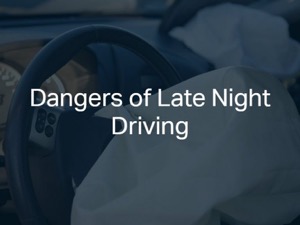
There are various reasons why driving at night presents more danger than driving during the day. Even though nighttime driving typically means that the roadways are less crowded, there are other dangers that crop up that could lead to significant injuries in the event of a collision occurs. Here, our Chicago personal injury lawyers want to discuss a few dangers that may not be specific only to nighttime driving but that are much more prevalent during the late-night hours.
Alcohol and Drug-Impaired Driving
Data available from the Illinois Department of Transportation shows that there were 1,010 total people killed as a result of alcohol-involved collisions during the latest reporting year across the state. Overall, alcohol was attributed to 27.1% of all fatal car accidents in Illinois that year.
Alcohol and drug impairment significantly decrease driver and passenger safety on the roadways. In general, alcohol and drug-impaired crashes are much more likely to occur at night. This is simply the time frame when more people are consuming alcoholic beverages to excess and using illegal narcotics.
Decreased Visibility
It seems rather obvious to say that nighttime driving results in decreased visibility, but it is necessary to put that on this list. We simply cannot see all of the hazards on the roadway when we are driving at night.
Another impediment to night driving is dirty windshields. Most people rarely clean the inside of their windshields, and it is not uncommon to not notice how dirty a windshield is until driving at night. Dirty or damaged windshields can scatter the light coming into a vehicle and can increase the effects of glare.
Inclement Weather and the Night-Time
Driving when the weather is hazardous is always a safety risk, regardless of the time of day. However, when there is a significant amount of rain, snow, or ice, driving at night becomes much more hazardous.
Personal Vision Problems
Did you know that, as we age, we experience greater difficulty with seeing at night? Some people simply have poor night vision, regardless of age. Additionally, many drivers have compromised vision due to various types of degenerative eye diseases.
Vision tests are required for a person to get their license. However, these tests do not measure a person’s night vision ability. It is strongly recommended that any person who struggles to see at night limit their driving to daytime hours.
Fatigued Driving
Studies show that an incredible amount of adults have driven while they are fatigued. Data available from the National Safety Council states that approximately half of all US adult drivers admit to getting behind the wheel consistently after feeling drowsy. Approximately 20% of these individuals admitted to falling asleep behind the wheel in the year leading up to the study.
These are incredibly shocking statistics. Drowsy driving put everyone at risk on the roadway. In fact, driving while fatigue comes with nearly the same risks as driving while impaired by alcohol or drugs.
Improperly Angled Headlights or High Beams
It is not uncommon for individuals to improperly angle their headlights too high, thereby shining them right into other drivers’ eyes. Some areas around the country require annual inspections to check headlight angles. Additionally, it is incredibly important to understand when it is appropriate and not appropriate to use high beams. It is recommended that individuals dim their high beams when they are within 500 feet of an oncoming vehicle so they do not temporarily blind the other driver.
 North Chicago & St. Louis Injury Updates
North Chicago & St. Louis Injury Updates

